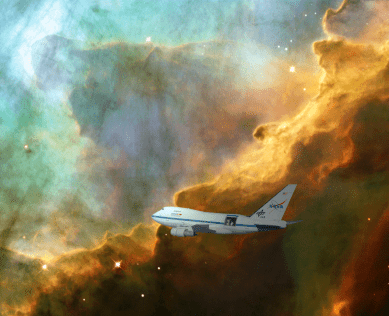Certain parts of the galaxy are more magical than others. There are barren wastelands where barely a particle strays through occasionally, and there are fantastical nebulae that can literally light up the sky. But beyond their good looks, those nebulae hold secrets to understanding some of the most important features of any galaxy – stars. Now, for the first time, a team from the University of Maryland managed to capture a high resolution image of one of the most active star-forming regions in our part of the galaxy. Data from that image are not only spectacular, but can illuminate the details of the star formation process.
The instrument the team used to collect the most important parts of the data, known as SOFIA, is an amazing air-based telescopes. Strapped to a modified 747 chassis, it specializes in capturing infrared images, just slightly out of the wavelengths that the human eye can see. SOFIA turned its eye on a star forming region known as Westerlund 2, which is located in the RCW 49 nebula. But the researchers didn’t stop there, using data collected in every wavelength from x-rays down to radio waves via different instruments.

Credit – Marc Pound / UMD
Luckily there was plenty of data to choose from. That region of space had been the focus of previous studies, which hinted that there might be two bubbles of warm gas surrounding the region. These types of gas bubbles have long been thought to play a role in star formation. Data from SOFIA definitively showed that there was in fact only one bubble, and that bubble is expanding. The most likely cause of that expansion is a stellar wind launched by the formation of a massive star somewhere within the bubble itself.
Gas bubbles aren’t the only material surrounding these formation regions though. They’re joined by a “shell” made up of a form of ionized carbon. Seen in the kaleidoscope of wavelengths the researchers analyzed, the shell and the gas bubbles intermingle with each other, but separating out individual wavelengths allowed for much higher resolution pictures of the bubbles (which were invisible in previous radio and sub-millimeter data) and shell (which glowed in a far-infrared band that SOFIA was able to collect).
With this ability to properly distinguish between the bubbles and the shell, the researchers were then able to apply that most tried and tested of velocity measuring technique in astrophysics – the Doppler effect. By monitoring the red and blueshift of the carbon atoms in the shell, the UMD researchers, led by Dr. Maitraiyee Tiwari and doctoral student Ramesey Karim, were able to construct a high resolution 3D image of this active star-forming region for the first time.
That detailed pictured allowed them to catch additional details that were invisible in lower resolutions. For example, the bubble surrounding the region had actually burst on one side about a million years ago, significantly slowing its expansion. But then another star formed inside the bubble, and the new stellar wind it caused accelerated the expansion back up again.

Credit: NASA, ESA and Jesús Maíz Apellániz (Instituto de Astrofísica de Andalucía, Spain).
Those details certainly won’t be the last to be found in the region either – the researchers predict Westerlund 2 will go on to form stars for millennia to come, with smaller and smaller stars forming over time. Hopefully, future astronomers with instruments far more advanced than any we have today, will be around to watch those formations take shape, giving us an even more detailed glimpse of this spectacular part of the galaxy.
Learn More
UMD – First Clear View of a Boiling Cauldron Where Stars are Born
The Astrophysical Journal – SOFIA FEEDBACK Survey: Exploring the Dynamics of the Stellar Wind–Driven Shell of RCW 49
Sci News – Westerlund 2’s Core is No Place to Form Planets, Astronomers Say
Sci-News – SOFIA Observes Stellar Wind-Driven Bubble around Westerlund 2
UT – Huge Stars Can Destroy Nearby Planetary Disks
Lead Image –
Image of the RCW 49 Nebula.
Credit – NASA / JPL-Caltech / E Churchwell (University of Wisconsin)

